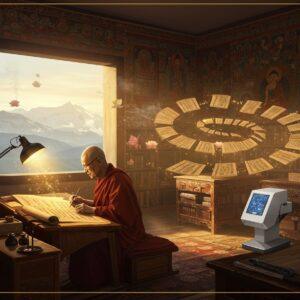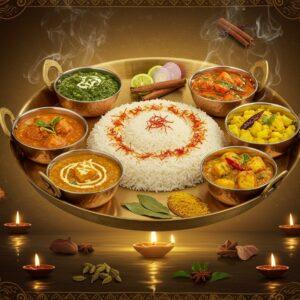
The rich tapestry of Indian performing arts offers a glimpse into the divine narratives of Dashavatara, the ten incarnations of Lord Vishnu. These avatars, each with their own significance, reflect divine interventions to restore cosmic balance. Across India, these stories come alive in traditional dance dramas, cherished by those who hold tradition close to their hearts.
Dashavatara Dance of Goa
The Dashavatara dance of Goa is a unique blend of drama, music, and dance. Rooted in the Bhagavata Purana, a sacred Hindu text, this performance showcases vibrant costumes, elaborate masks, and folk music to depict the ten avatars. Often presented during religious festivals, it plays a vital role in preserving local folklore and traditions. Community involvement is strong, with knowledge passed down through generations of performers. It’s a vibrant spectacle that brings mythology to life.
Dashavatara Bharatanatyam
In Tamil Nadu, Bharatanatyam incorporates Dashavatara themes. This classical dance form uses expressive hand gestures (mudras), facial expressions (abhinaya), and intricate footwork to narrate Vishnu’s stories. Celebrated works like the ‘Dashavatara Kritis’ by Muthuswami Dikshitar are renowned examples. These dances transcend mere performance, conveying profound moral lessons and philosophical ideas, enriching the spiritual experience of the audience.
Dashavatara Yakshagana
Karnataka’s Yakshagana brings Dashavatara to life with its theatrical flair. Known for its elaborate costumes, headgear, and makeup, Yakshagana relies on the Bhagavata, the lead singer and narrator, to guide the performance. Its improvisational nature allows performers to connect these ancient stories to contemporary issues, creating a resonant experience for modern audiences. The interactive element, with strong audience participation, transforms the performance into a dynamic exchange with the divine.
Cultural Significance and Modern Adaptations
Dashavatara performances play a crucial role in fostering identity and continuity within Indian communities. They bridge the past and present, upholding traditional values while embracing modern interpretations. The use of digital media and the emergence of fusion performances extend the reach of Dashavatara to broader audiences, creating new avenues for appreciation and understanding. Preserving these art forms in today’s fast-paced world presents both challenges and exciting opportunities for cultural growth.
Explore the Vibrant World of Dashavatara Dance Drama
Dashavatara is a captivating traditional dance drama form that vividly portrays the ten incarnations of Lord Vishnu. With a history spanning 800 years, it holds a special place in the Konkan region, particularly among the farming communities of Sindhudurg (Maharashtra) and North Goa. The performances, typically held at night in open-air settings, are a vibrant celebration of culture and spirituality.
Understanding the Ten Incarnations
The essence of Dashavatara lies in its depiction of Lord Vishnu’s ten avatars: Matsya, Kurma, Varaha, Narasimha, Vaman, Parashuram, Ram, Krishna, Buddha, and Kalki. Each avatar unfolds a unique narrative of divine intervention to restore cosmic balance, offering profound insights into Hindu mythology and philosophy.
The Theatrical Experience
Dashavatara performances are typically evening events, often presented in open-air venues. The drama is structured in two parts: the ‘poorva-ranga’ (preliminary section) and the ‘uttara ranga’ (main performance), with the latter centered around mythological stories. Performers adorn themselves with bright makeup and elaborate costumes, bringing the avatars to life. The music, played on instruments like the paddle harmonium, tabla, and zanj (cymbals), complements the rhythmic movements and adds to the overall immersive experience. Traditionally, all roles, including female characters, were played by male performers.
Regional Variations
In Goa, the performance commences with the Sutradhar (stage manager) enacting the theft of the Vedas. This sets the stage for a vibrant portrayal of rivers, Brahmins, gods, goddesses, and demons. The core drama, known as “Akhyana,” draws from Indian epics and mythologies, with local variations adding a unique regional flavor to the narrative. These adaptations reflect the diverse cultural influences within the tradition.
Social and Cultural Importance
Dashavatara serves as a significant social and cultural event, bringing communities together in celebration and shared experience. These performances are vital for preserving local folklore and customs, ensuring the transmission of traditions across generations. They reinforce cultural identity and strengthen community bonds.
Modern Adaptations
In the digital age, Dashavatara finds new life through fusion performances and online platforms, reaching wider audiences and offering contemporary interpretations while honoring the essence of this cherished art form. These adaptations ensure the relevance and continuity of the tradition in the modern world.
How Poojn.in Supports Your Dashavatara Performances
Poojn.in offers a wide selection of products ideal for authentic Dashavatara performances and celebrations:
- Complete Pooja Sets: Ready-to-use kits containing all the essentials for Vishnu worship and Dashavatara ceremonies. These sets offer convenience and ensure you have everything you need for a proper observance.
- Brass Idols: High-quality brass idols of Dashavatara deities are available in various sizes, suitable for both stage performances and home worship. Browse our collection of brass idols.
- Traditional Costumes: Authentic outfits and accessories capture the distinct characteristics of each avatar, adding authenticity to your performances. We offer a wide range to choose from, ensuring you find the perfect representation for each incarnation.
- Sacred Texts: Printed versions of the Vishnu Purana and other relevant texts containing Dashavatara stories are available for study and reference, deepening your understanding of the narrative.
- Ritual Items: Essential ritual items such as pure copper kalash, brass bells, incense holders, traditional lamps, and puja thalis are available to enhance the authenticity of your ceremonies. Learn more about the significance of Aarti.
All items on Poojn.in are verified for authenticity and ritual compliance. We offer pan-India delivery with secure packaging to protect your sacred items. Our dedicated customer service team is available to guide you on product selection and proper usage for performances and ceremonies.
Visit www.poojn.in or call our toll-free number for product details and ordering. We help you maintain traditional authenticity in your Dashavatara performances with the convenience of online shopping.
A Timeless Tradition Continues
Dashavatara represents a beautiful fusion of history, spirituality, and art. Its vibrant depictions of Lord Vishnu’s ten incarnations offer a glimpse into an ancient tradition that continues to flourish. These captivating dance dramas bridge the past and present, allowing audiences to connect with the divine stories that have shaped our cultural heritage. Whether experienced in a traditional setting or through modern adaptations, Dashavatara remains a cherished art form that enriches our understanding and appreciation of India’s rich spiritual and cultural legacy.
FAQs on Dashavatara in Performing Arts
What is Dashavatara in performing arts? Dashavatara in performing arts refers to artistic representations of Lord Vishnu’s ten incarnations, showcasing each avatar’s unique story and significance through various mediums like dance, drama, and music. These performances often highlight the avatars’ roles in restoring cosmic balance and upholding dharma.
How is Dashavatara represented in Bharatanatyam? Bharatanatyam portrays Dashavatara through a combination of expressive dance movements, intricate footwork, hand gestures (mudras), and abhinaya (facial expressions) to narrate the stories of Vishnu’s ten avatars. Specific compositions, like the ‘Dashavatara Kritis,’ are dedicated to these incarnations.
What is unique about the Dashavatara Dance of Goa? The Dashavatara Dance of Goa stands out as a traditional folk performance known for its vibrant costumes, elaborate masks, and lively music. It blends drama and dance to depict the ten avatars, playing a significant role in preserving local folklore and traditions.
How does Yakshagana depict Dashavatara? Yakshagana, a traditional theatre form from Karnataka, brings Dashavatara to life through its distinctive style, featuring elaborate costumes, makeup, and powerful storytelling led by the Bhagavata (singer-narrator). The performances often emphasize the moral and philosophical lessons embedded in each avatar’s story.
Why are Vishnu’s ten incarnations important in performing arts? Vishnu’s ten incarnations hold profound significance in performing arts as they embody divine intervention in the world. Each avatar represents distinct values and teachings, providing rich material for artistic exploration and expression, inspiring both performers and audiences.
Which performing arts form is most popular for depicting Dashavatara? While numerous art forms depict Dashavatara, Bharatanatyam and Yakshagana are particularly renowned for their detailed narrative styles and deep cultural significance in portraying these incarnations.
How do performers prepare for Dashavatara roles? Preparing for Dashavatara roles requires rigorous training in dance techniques, expression, and storytelling. Performers delve into religious texts to understand the deeper meaning of each avatar’s story, embodying the essence of the character they portray.
Can Dashavatara be adapted into modern performances? Yes, Dashavatara themes are frequently incorporated into contemporary performances. Artists blend traditional narratives with innovative techniques to engage new audiences, demonstrating the enduring relevance of these ancient stories.


